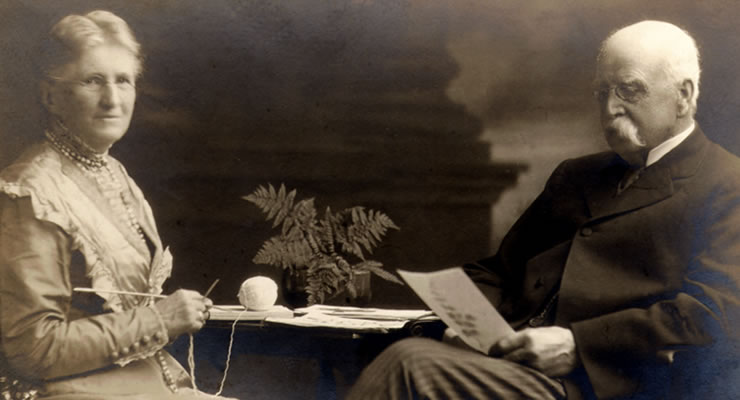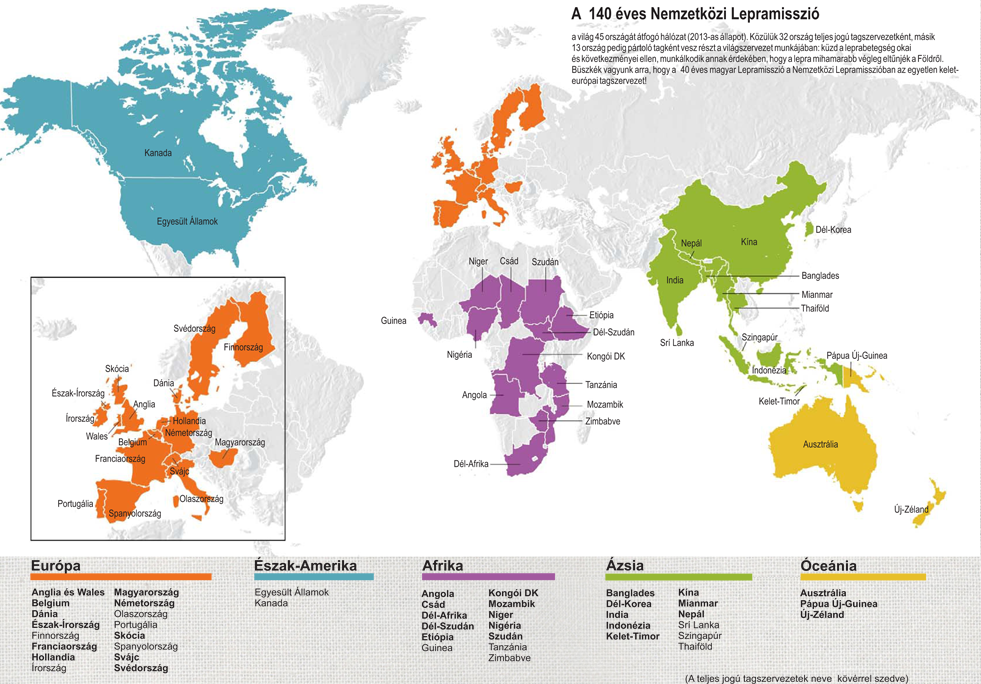It was founded by a wealthy Irishman, Wellesley Cosby Bailey (1846-1937) and his wife Alice Graham. In his youth, Bailey often visited India and enjoyed the enchanting beauty and riches of the 'fabulous East'. For a long time, all he saw of India was the treasures and riches that could be brought home to Ireland.
In the 1870s, however, his eyes were opened to something else: the immense poverty, the begging lepers scratching their wounds along the roadsides. As a teacher in the village of Ambala, in the Indian state of Punjab, he met leprous beggars every day, and was deeply moved by their misery and hopelessness. From that moment on, his mind was turned around and he could not help wondering: what could he give India with all the good he had?
This is how he was inspired to work with lepers.

He set out on a mission of charity, which he immediately involved his friends in when he returned home. At their first missionary meeting (1874), held at the Pim Sisters' house in Monkstown, near Dublin, they decided to establish the 'Lepers' Mission of India' with a capital of 30 gold pounds.
By 1917, the year of Bailey's death, the organisation was running 87 programmes in 12 countries!

One of his grandchildren wrote of W.C. Bailey: "He was not without faults, and he was not a particularly clever man. But I never heard him make a hurtful remark or show any ill temper. The greatest gift of his life was the single-mindedness of purpose and wonderful 'simplicity' with which he was able to carry out his calling and overcome all obstacles."
From this unique beginning has grown what is now the largest leprosy organisation in the world: The Leprosy Mission International (www.leprosymission.org), which now includes 33 member countries.
In 1874, there was no way to cure the sick. What Bailey and his colleagues could do for the suffering at that time was to provide loving and humane care and nursing until death.
However, leprosy is now curable! Since the 1980s (when the use of combination therapies was introduced in leprosy treatment), more than 15 million patients have been cured in International Leprosy Federation facilities worldwide!
Unfortunately, the fight will not be over for a long time. Although leprosy is now curable, it is not yet medically preventable and there is no vaccine. The most effective prevention is the elimination of deep misery. We are trying to do as much as possible to heal the wounds of humanity.
Be our colleague!
History of the International Lepramism Mission
In 1874, Wellesley Cosby Bailey founded the organisation by launching an appeal among his friends to help leprosy patients in India.
Bailey was a wealthy Irish man who was working as a charity teacher in India with his wife Alice. Meanwhile, he saw a crowd of untreated, cast-out lepers around him, deeply moved and reminded of all he had read about Jesus in the Bible.
On his return to his home country, he shared his experiences with friends in Dublin. They started a collection among themselves, the result of which, 30 gold pounds, was the "seed money" for the later International Lepramism Mission.
By 1878, the result was 900 gold pounds, which was used to finance the care of their families and the lepers in Punjab. At that time, leprosy could not be cured, only care and nursing could be made loving and humane for the patients.
In subsequent years, support was extended to leprosy patients in Burma, Japan, Indonesia, Korea, Thailand, China, Central Africa, Nigeria, Hong Kong and Papua New Guinea. Support groups were formed in Australia, Canada, New Zealand and several countries in Western Europe, where they contributed to the Baileys' work through prayer and donations.
From its humble beginnings, the International Lepramism Union has grown into an organisation of 33 member countries. Through quality outreach, we seek to make the love of Jesus heard and seen through all that we do for those who are suffering and their loved ones.
Wellesley Bailey testified, "This mission was born in prayer, it was cradled in prayer, and prayer is its sustaining power." We have not wavered from that objective since.
Key dates, milestones
The pre-cure period
In the first 66 years of our mission, there was no cure for leprosy. The aim of the mission was to provide care for the sick in the name of Jesus with much love.
1866 Wellesley Bailey is a 20-year-old Irishman sailing from London to Australia to make his fortune in the gold trade. On the voyage he receives a divine calling. He dedicates the rest of his life to God
1869 Unable to make a fortune, he is disappointed and goes to India, where one of his brothers is in the army. His intention was to join the police force, but he increasingly felt a strong missionary calling. So he joined the Presbyterian Mission in America. He became a teacher in Ambala, Punjab
1873 Armauer Hansen discovers the leprosy pathogen in Norway! In the same year. Joseph de Veuster (Father Damian), a Belgian missionary priest, sails from Honolulu to the island of Molokai (commonly known as "the island of death") to be a physical and spiritual support for the lepers sent there. He wrote: "If there is a Christian mission in this world, this is it! To go among the suffering, to tell them the good news of Jesus, because he loved and cared for the lepers during his earthly life!"
1871 Wellesley Bailey marries his fiancée Alice in India
1874 With donations from Bailey and friends (30 gold pounds), the "Indian Lepers Mission", now the International Leprosy Mission, is born. All this happened 66 years before the cure for leprosy was discovered! - By the following year, 600 gold pounds had been collected!
1874-93 Bailey and his wife advertise the cause more and more extensively in their home country. First they join the work of other missions to care for lepers and their families. Later, the organisation sets up its own hospitals
1884 Mary Reed becomes director of the Chandag Hospital in India! Miss Reed is on the staff of "The Indian Lepers' Mission"!
1893-1913 From India, the mission's activities spread to Burma, Japan, Thailand and Korea. By this time, collections were already being made in many of the countries in the background!
1897 The first World Congress on Leprosy is held in Berlin
1914 The mission grows even during World War I! By that time, leprosy support groups were operating in New Zealand, Ireland, the UK, Canada, Australia, Switzerland and Hong Kong, raising funds
1917 Wellesley Bailey retires from mission leadership. He is succeeded by William Anderson
1937 Wellesley Bailey dies at the age of 91
The age of curability
The discovery of a cure for leprosy is a very slow, steep climb, the final fruit of the labour of many, many scientists. Until then, attempts had been made only to use various plant derivatives: for example, oil of gurgan, an extract of a tree of the teak family, and later oil of chalcogre, which is very painful to administer by injection but has little effect.
1941 The first real chemical cure was administered to leprosy patients by the American Dr Faget, who gave a derivative of sulfone, discovered a few decades earlier. The results are encouraging, paving the way for the discovery of a cure for leprosy! Over the next 15 years, millions of leprosy patients were given the sulfone-containing drug, Dapsone or its equivalent
1946 Dr Paul Brand, a famous American leprologist, experiments a life-changing hand surgery technique in Karigiri, South India, which restores the use of paralysed hands and thus the patient's ability to work! Gradually, similar reconstructive surgeries are being performed in all International Leprosy Federation institutions!
1950s The International Lepramism Mission grows significantly on African soil
In these years, our mission changes its previous position and starts sending missionaries to Africa and Asia to do leprosy work. Previously, for a long time, Mary Reed was our only missionary!
1954 On the initiative of French journalist Raoul Follereau, the "World Leprosy Day" is held for the first time on the Sunday closest to Gandhi's death: the last Sunday in January.
The number of countries supporting Lepramism continues to grow: by 1975, there are now 14 countries!
1960 Unfortunately, mutants resistant to Dapsone are rearing their heads! The world's only effective leprosy drug is becoming increasingly ineffective!
In 1962 in Nigeria, Dr Stanley Browne and Frank Davey discover that clofazimine (lamprene) is also a powerful leprosy drug, and even effective against leprosy reactions due to its anti-inflammatory properties!
1965 "The Mission of the Lepers" is renamed "The Leper Mission" because of the wrong sound
1966 The leprosy world organisation ILEP is established
1967 A team of researchers including Dr Michael Waters, a medical researcher with the Lepramism Society, shows that rifampicin is also an effective leprosy drug!
1970s The former static, hospital-centred medicine is increasingly replaced by outpatient care. Extensive screening campaigns are launched and the Mission develops its outpatient network. Meanwhile, it is training large numbers of health workers everywhere and launching educational programmes
1974 We give thanks for the 100 years of the International Lepramism Mission
1981 WHO introduces a new triumph in leprosy treatment: multidrug therapy, a "cocktail" of several drugs: dapsone, rifampicin, clofazimine. It is successful and effective!
1982 The International Leprosy Federation signs up to the WHO to provide combination drug treatment for patients in all its institutions
1990 The International Leprosy Federation joins the ILEP goal of eradicating leprosy from the face of the earth by the year 2000!
1991 The WHO target for 2000 is to reduce the incidence of leprosy in affected areas to below the public health threshold by the year 2000 (i.e. 1 or fewer cases per 10 000 people)
The 1990s In the 1990s, we build up a rehabilitation network alongside our medical care. We also expand our dermatology, ophthalmology and TB treatment activities in all our hospitals and areas
1992 Although combination drug therapy remains the most effective, new drug trials are being developed to shorten the recovery time
1994 We create our international network for patient advocacy: IDEA
1997 Better and better medicines are being developed to shorten the recovery time from 24 months to as little as 12 months.
1999 The International Lepramis Federation celebrates 125 years of existence
2000 At the dawn of the new millennium, our declared goal is the same as before: to eradicate leprosy from the face of the Earth as soon as possible!
Can you help me with this?
Thank you!

